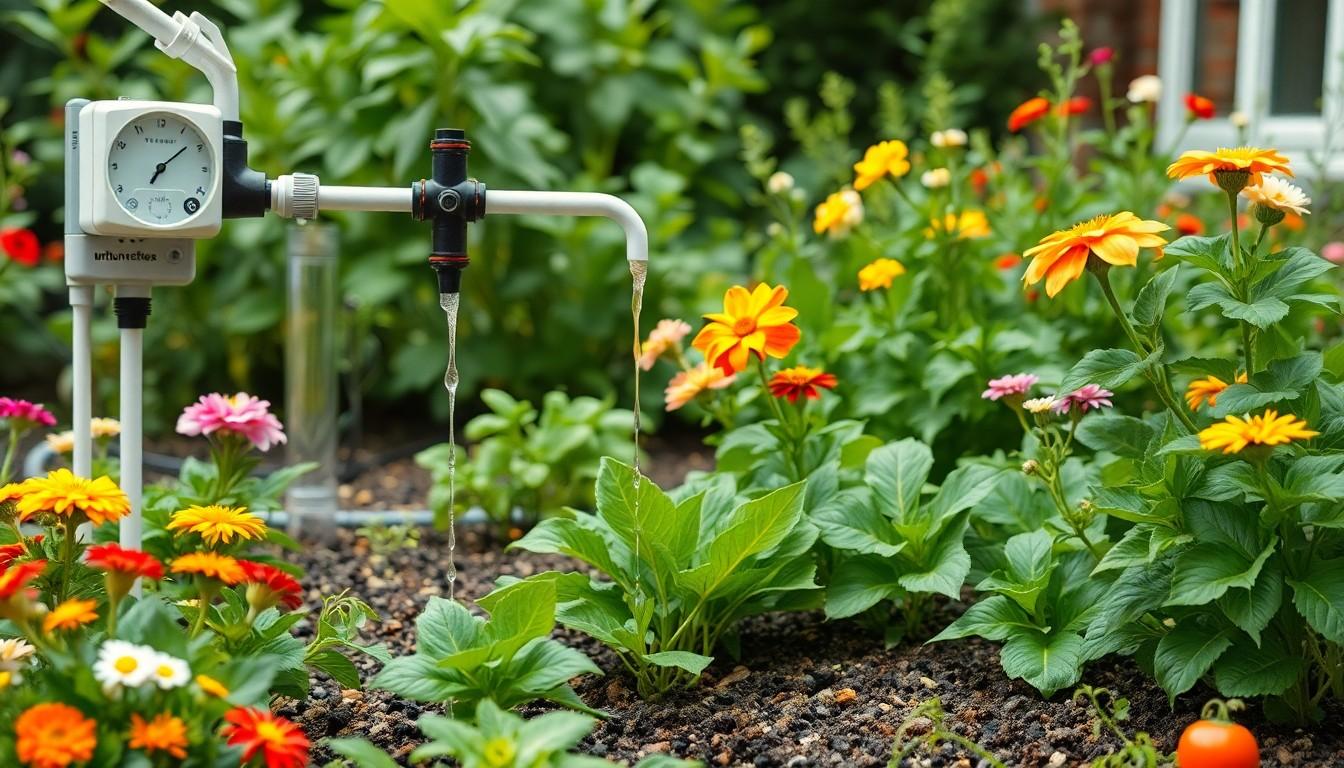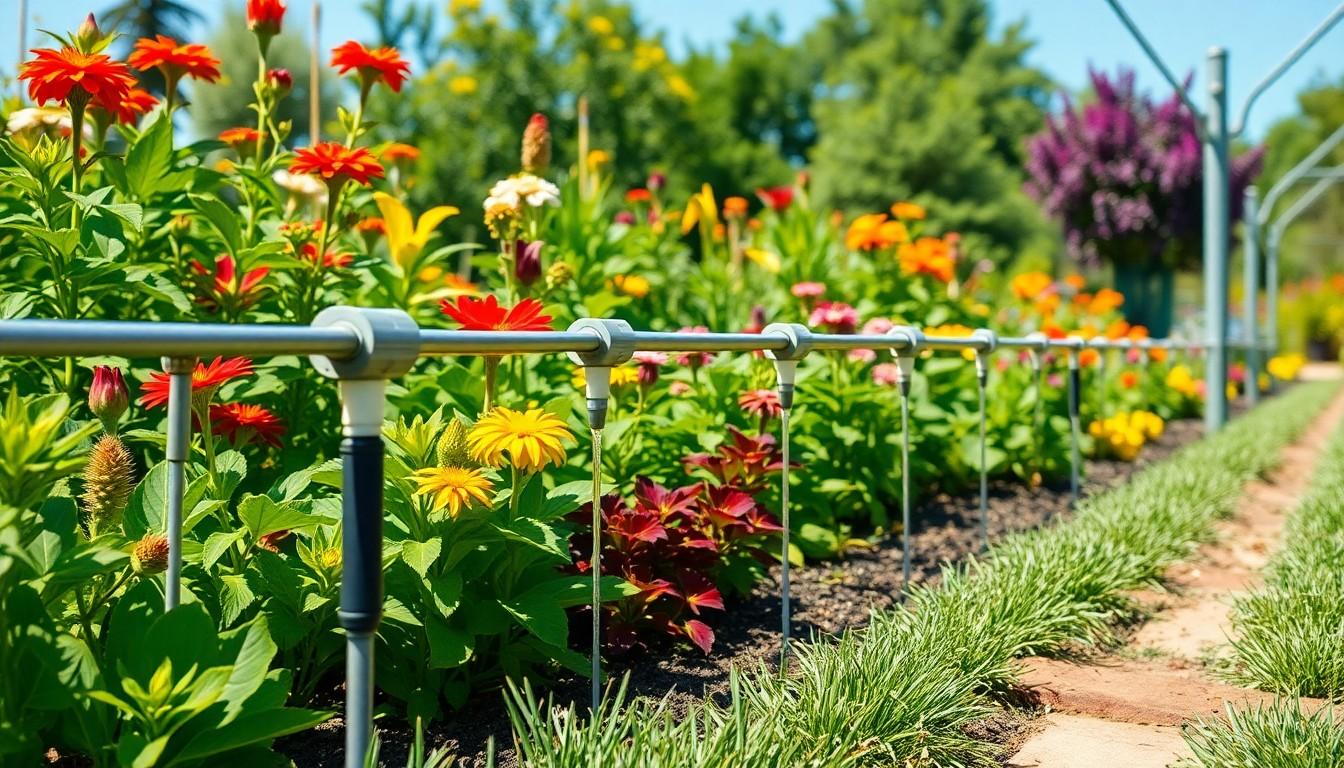Imagine a world where your garden thrives without you having to play the role of a human sprinkler. An automatic watering system can turn that dream into reality, giving plants the hydration they crave while you kick back and enjoy a cup of coffee. No more wrestling with hoses or getting soaked in the process—just set it and forget it!
Overview Of Automatic Watering Systems
Automatic watering systems provide an efficient solution for maintaining gardens. These systems consist of components like timers, sensors, and irrigation systems that deliver water precisely when plants require it. Simple installation makes these systems accessible for most gardeners.
Various types exist, including drip irrigation, sprinkler systems, and soaker hoses. Drip irrigation delivers water directly to plant roots, reducing evaporation and ensuring efficient water usage. Sprinkler systems cover larger areas and can be adjusted for different hydration needs. Soaker hoses allow water to seep into the soil slowly, promoting thorough moisture absorption.
Timers serve as a critical element within these systems. Programmable timers allow users to schedule watering sessions based on specific times or plant needs. Smart timers can adapt to weather changes, adjusting watering frequency automatically. This adaptability prevents overwatering or underwatering.
Sensors enhance the functionality of automatic watering systems. Soil moisture sensors measure moisture levels, triggering the system when it detects dryness. Rain sensors prevent activation during wet weather, conserving water resources and avoiding soggy soil.
Low maintenance requirements contribute to the appeal of automatic watering systems. Once set up, these systems operate independently, freeing gardeners from constant monitoring. Regular checks ensure components are functioning efficiently and maintain optimal conditions for plant growth.
Overall, automatic watering systems support plant health and reduce water waste. Gardeners experience less stress associated with manual watering, allowing for more time spent enjoying their gardens. With these systems in place, garden care becomes simplified and effective.
Benefits Of Automatic Watering Systems

Automatic watering systems significantly enhance garden care by providing consistent and efficient hydration to plants. These systems offer several key benefits, particularly in the context of water savings and time efficiency.
Water Savings
Water conservation ranks as a primary advantage of automatic watering systems. Research indicates that these systems can reduce water usage by up to 50% compared to traditional watering methods. Drip irrigation techniques target specific plants, minimizing evaporation and runoff. Timers and sensors prevent overwatering by adjusting output based on soil moisture levels. Such efficiency not only conserves resources but also lowers water bills over time. By optimizing water distribution, these systems ensure plants receive hydration precisely when needed, promoting healthier growth and decreasing waste.
Time Efficiency
Time savings represent another compelling benefit of automatic watering systems. Gardeners save hours that typically go toward manual watering. Systems with programmable timers allow for customized watering schedules that work around individual needs. Hands-free operation results in less physical strain and allows gardeners to focus on other tasks. Smart irrigation technology can adjust schedules based on weather forecasts, eliminating unnecessary watering during rainfall. This efficiency fosters a more manageable gardening experience, enabling passion for plants rather than obligatory maintenance.
Types Of Automatic Watering Systems
Various automatic watering systems cater to different garden needs. Understanding these types helps gardeners choose the best solution for their plants.
Drip Irrigation Systems
Drip irrigation systems deliver water directly to the soil around plant roots. This method reduces evaporation and ensures efficient water usage. Tubing and emitters work together to provide consistent moisture, preventing overwatering. Installation often involves flexibility, allowing for customization in various garden layouts. Many gardeners appreciate how drip systems minimize weed growth by keeping water focused on the plants. Furthermore, these systems can be equipped with timers and sensors for enhanced control.
Sprinkler Systems
Sprinkler systems use rotating or fixed heads to spray water across a designated area. They cover larger spaces effectively and can reach multiple plants simultaneously. Automatic timers facilitate convenient scheduling, catering to specific watering needs throughout the week. Adjustment capabilities allow gardeners to change spray patterns based on season or weather conditions. Additionally, these systems often feature oscillating or stationary options, ensuring versatility in watering approaches. Sprinkler systems promote deep root growth by delivering water uniformly across lawns and gardens.
Installation Process
Setting up an automatic watering system involves careful planning and selecting the right components. Following these steps can ensure effective irrigation for any garden.
Planning Your Garden Layout
Creating a garden layout is essential before installation. Gardeners should map out plant locations to determine the best watering system. Identify sun and shade areas, as these influence moisture needs. Placement of plants can dictate the type of watering system needed for optimal hydration. Designing pathways and accessing water sources remains crucial for efficient watering. Evaluating how different sections require varying amounts of water helps in custom design. This thorough understanding leads to a tailored system that meets all garden requirements.
Choosing The Right Components
Selecting components impacts the performance of the automatic watering system. Timers must be programmable to ensure scheduling aligns with plant watering needs. Sensors enhance efficiency by measuring soil moisture, reducing unnecessary watering. Drip irrigation systems typically benefit from emitters designed to deliver water precisely to roots. Sprinkler systems often require heads that can cover entire garden areas effectively. Evaluating additional features like filters or pressure regulators contributes to longevity. Thoroughly researching components allows gardeners to invest in systems that suit their unique horticultural demands.
Maintenance And Troubleshooting
Regular maintenance ensures the automatic watering system operates efficiently. Check hoses and connections for leaks and damage. Inspect filters frequently, as debris can clog them and disrupt water flow. Clean emitters and sprinkler heads regularly to prevent blockages that affect performance.
Adjust schedules based on seasonal changes to accommodate varying water needs. Consider modifying the system if plants show signs of over or underwatering. Monitoring soil moisture levels helps identify adjustments for optimal watering.
Identifying common troubleshooting issues saves time and resources. If the system fails to activate, first examine the power source, and then inspect the timer settings. Verify sensor functionality to ensure it triggers correctly based on moisture thresholds. For dripped systems, check for clogged emitters, and replace any that don’t release water adequately.
Responding swiftly to issues minimizes stress on plants. Sudden changes in water pressure may indicate a pipe obstruction or a leak. Timely repairs prevent extensive damage and support healthy plant growth.
Exploring resources, such as manufacturer websites or gardening forums, offers solutions for specific problems. Many communities provide advice on troubleshooting common challenges, helping gardeners optimize their systems. Utilizing professional services can also address persistent issues that DIY troubleshooting can’t resolve effectively.
Staying proactive with maintenance and troubleshooting helps maintain an effective automatic watering system. This practice guarantees plants receive consistent care while minimizing water waste and ensuring optimal health.
Conclusion
Embracing an automatic watering system transforms the gardening experience. Gardeners can enjoy the luxury of hands-free plant care while ensuring their greenery thrives. With efficient technology like timers and sensors, these systems not only conserve water but also promote healthier plants by delivering precise hydration.
Choosing the right system tailored to specific garden needs simplifies maintenance and enhances overall growth. Regular checks and adjustments ensure optimal performance and prevent potential issues. By investing in an automatic watering system, gardeners can focus on their passion rather than the routine of manual watering, making gardening a more rewarding endeavor.

